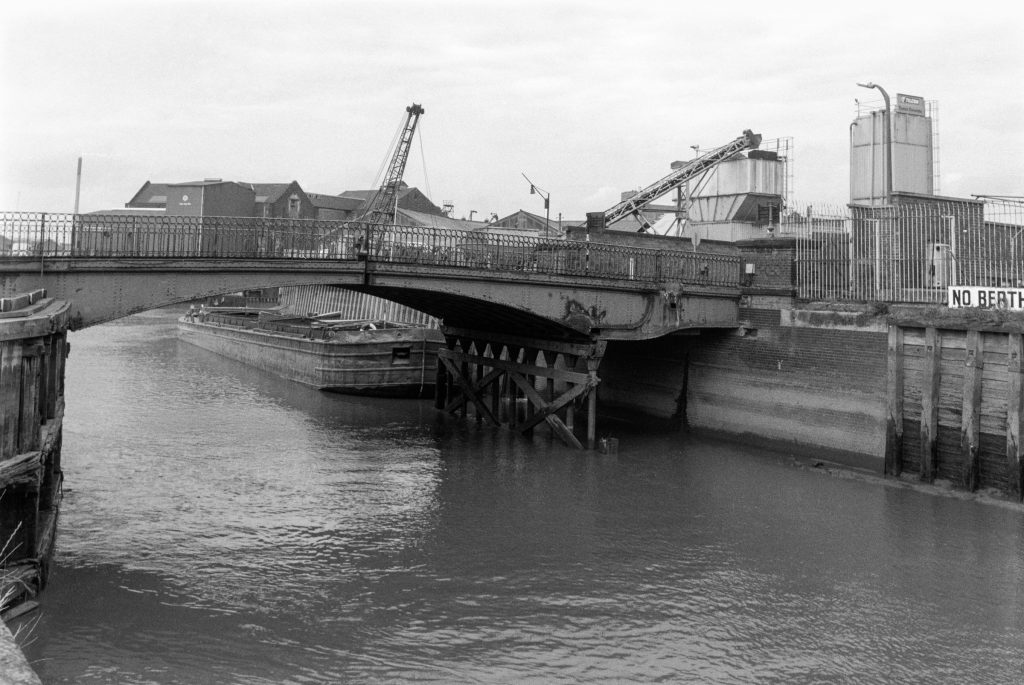More River Hull, Lime St and Wincolmlee – pictures made in August 1989
Looking across the River Hull from the riverside path through the scrap metal you can see the Drypool Bridge and the converted warehouses on Clarence Street between High St and the River. Further to the right are the gates of a dry dock and I think the chimneys of Blaydes House, now the University of Hull Maritime History Institute at I High St.
Swinging around a little brings a second set of dock gates into view, and this was the entrance to Hull’s first inland dock, needed as the Old Harbour on the river bank was getting far too congested. The Hull Dock company, founded in 1783 and the first of its kind, built the dock and opened it in 1788 simply as the Dock. It was built close to the site of Hull’s medieval walls and the street just to the south of the former dock is still called North Walls. The dock was renamed Queen’s Dock when Victoria visited in 1854 and all but the short section between the river and Dock Office Row was filled in in the 1930s and reopened as Queens Gardens in 1935.
The Yorkshire Dry Dock Co Ltd, Ship Builders Ship Repairers were incorporated in 1917, but there had been dry docks here much earlier as a detailed study in Paul Gibson’s Hull and East Yorkshire History relates. Hull’s Arctic Corsair, currently being restored, is expected to open to visitors at North End Shipyard in early 2025.
Lime street runs parallel with the River Hull on its east side from North Bridge to Scott Street Bridge, and then on to the busy industrial Cleveland Street, always in the 1980s one of Hull’s dustiest streets. Between Lime Street and the river were a number of wharves and many were still in use in 1989, and some businesses here still had some maritime connection.
This picture is looking south down Lime Street from its junction with Jenning Street. I turned into Jenning Street. There are some bulk storage tanks and timber storing sheds in the middle distance and three large of cranes suggesting some large redevelopment.

Back in 1989 I was still able to cross the river on Scott Street Bridge. I think Hull Council had long wanted to close this Grade II listed hydraulic double leaf bascule bridge and had deliberately failed to maintain it, allowing salt water to corrode its mechanism. Finally in 1994 they pronounced it unsafe.
It hit the national headlines in January 2018, when Banksy came to to Hull and drew a figure of a young boy brandishing a pencil for a sword called “Draw the Raised Bridge”. The council removed the Banksy in October 2019 and then demolished the bridge completely. Some noises were made by the council about replacing it with a replica, but don’t hold your breath.
A man cycles down the Scott Street Bridge approach with its warning lights for bridge openind. On the other side of the long railing is Wincolmlee, the street which follows the River Hull on its west side.Two Buildings belonging to Pauls Agriculture Ltd are linked across the street by a bridge.
Pauls Agriculture was founded in Ipswich in the early 19th century initially as traders in malt and barley, but by the twentieth century there main business as in maize, which they crushed to produce vegetable oils for soap and other industrial uses with the remaining oil cake being used to produce animal feeds. In 1992 they merged with BOCM.
Much of the maize was imported, from the USA and elsewhere, so a riverside site made sense. But when transport by road took over it made more sense to site crushing mills in agricultural areas.
More to follow from Hull in August 1989 – and there are more pictures on Flickr in both black and white and colour.
Flickr – Facebook – My London Diary – Hull Photos – Lea Valley – Paris
London’s Industrial Heritage – London Photos
All photographs on this page are copyright © Peter Marshall.
Contact me to buy prints or licence to reproduce.











